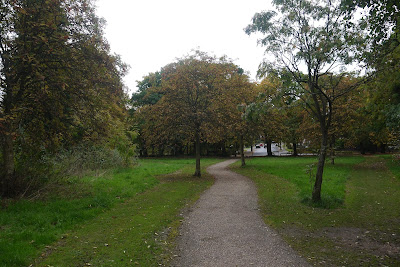On Sunday I was back at RSPB Sandwell Valley for my monthly volunteering stint. Although the forecast had been for sunny spells, the day ended up being one of blazing sunshine and cloud-free skies and I felt a bit overdressed in my woolly jumper (I am ready for winter!). The calm conditions meant that there wasn't much out of the ordinary around but we had an enjoyable day nonetheless.
Alf and I started the day with our usual walk around the reserve. We began by heading up to the horse paddock as I thought I'd spotted a Fox sunbathing there (as they often do) from the car on the way in. When we got to the paddock there were no signs of life, so we turned around to walk down to the river, only to see a bushy russet tail whisk away into the undergrowth on the other side of the road! The sneaky fox had probably been watching us the whole time! So I was unsuccessful in my attempts to get a Fox photo, but here are a few other photos of the reserve looking splendid in the early autumn sun.
 |
| The woodland around the path leading down to Kingfisher Corner. |
 |
| Not 100% sure but I think this is Prickly Sow-thistle (Sonchus asper). |
 |
| A very shiny iridescent beetle on some Nettles. My identification efforts only got me as far as some kind of leaf beetle, can anyone else identify it more conclusively? |
 |
| Forge Mill Lake. |
 |
| The new nature-themed screen looking over the marsh. |
We saw a pair of what we were 90% sure were Ravens flying down the railway line near the bridge - they zoomed past us so we only caught a glimpse, but their apparent large size, longish-looking tails and the whoosh of air against their powerful wings gave us definite Raven vibes. Along the River Tame we saw Grey Wagtail and Meadow Pipit, some nice views of Snipe on the far side of the islands, several Buzzards up and enjoying the clear skies, and there was lots of Jay action, unsurprising for the time of year. We saw a fair few busily ferrying acorns around, causing us to ponder the mutualistic relationship between Jays and Oaks, and also between other species of jay and tree. I then started thinking about jays generally and how awesome they are - I have only seen three jay species (Eurasian, Siberian and Blue); how amazing would it be to see every jay species in the world!
From the hide Teal had increased in number since my last visit and there seemed to be plenty of Gadwalls quacking around, but only a few Shovelers and one Pochard. The Kingfishers were putting on a good display once again, they seem to have become used to using the numbered posts around the Lake edge as perches. We also heard the squeal of a Water Rail which remained typically hidden in the reeds, and the Lapwings were very jumpy indeed, all taking flight at the slightest provocation. Our best sighting of the day was a Mediterranean Gull roosting with the Black-headed Gulls; it was preening its snowy plumage with one hefty bill! I enjoyed playing with my new camera once again; here are some of the results:
 |
| A Coot enjoying Alf's apple core. |
 |
| Lapwings. |
 |
| A Coot reflecting. |
Due most likely to the pleasant weather, the hide was very busy so I sadly didn't have much time for drawing. Here's what I produced; I think it's probably my best attempt yet at a Snipe (previous efforts have been pretty terrible!):
 |
| Snipe and aborted Gadwall sketches. |
Finally, back in the centre, I picked up a copy of the new RSPB Sandwell Valley Flora produced by SandNats. Looking forward to getting stuck into this!
 |
| Essential reading for Sandwell Valley fans. |
































